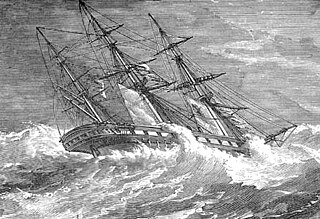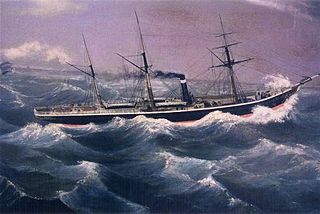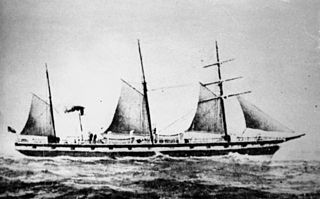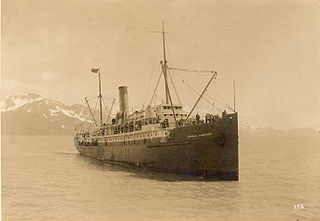
SS Princess Sophia was a steel-built passenger liner in the coastal service fleet of the Canadian Pacific Railway (CPR). Along with SS Princess Adelaide, SS Princess Alice, and SS Princess Mary, Princess Sophia was one of four similar ships built for CPR during 1910-1911.

SS Valencia was an iron-hulled passenger steamer built for the Red D Line for service between Venezuela and New York City. She was built in 1882 by William Cramp and Sons, one year after the construction of her sister ship Caracas. She was a 1,598 ton vessel, 252 feet (77 m) in length. In 1897, Valencia was deliberately attacked by the Spanish cruiser Reina Mercedes off Guantanamo Bay, Cuba. The next year, she became a coastal passenger liner on the U.S. West Coast and served periodically in the Spanish–American War as a troopship to the Philippines. Valencia was wrecked off Cape Beale, which is near Clo-oose, on the west coast of Vancouver Island, British Columbia, on 22 January 1906. Since her sinking killed 100 people, some classify the wreck of Valencia as the worst maritime disaster in the "Graveyard of the Pacific", a famously treacherous area off the southwest coast of Vancouver Island.
Sitkalidak Island is an island in the western Gulf of Alaska in the Kodiak Island Borough of the state of Alaska, United States. It lies just off the southeast shore of Kodiak Island, across the Sitkalidak Strait from the city of Old Harbor. The island has a land area of 300 square kilometers (120 sq mi) and no resident population.

Torrent was an American three-masted wooden sail ship that shipwrecked near the coast of Alaska on 15 July 1868. Torrent was built in Bath, Maine in 1852. It was made of wood, weighed 576 tons, and likely measured 50 meters in length. The ship consisted of two decks.

SS Admella was an Australian passenger steamship that was shipwrecked on a submerged reef off the coast of Carpenter Rocks, south west of Mount Gambier South Australia, in the early hours of Saturday 6 August 1859. Survivors clung to the wreck for over a week and many people took days to die as they glimpsed the land from the sea and watched as one rescue attempt after another failed.

The James B. Colgate was a whaleback steamer that sank off the shores of Long Point, Ontario, Canada, in Lake Erie on 20 October 1916. This day was dubbed "Black Friday" because of its fierce winds and towering waves wreaking havoc on numerous vessels traveling on Lake Erie's waters. The James B. Colgate, loaded with coal, left on its final voyage from Buffalo, New York, heading for Fort William, Ontario today known as Thunder Bay. The vessel had a tonnage of 1,713 tons and measured 308 feet (94 m) in length. Captain Walter Grashaw was the only surviving member of the 26-man crew.

The SS Gothenburg was a steamship that operated along the British and then later the Australian and New Zealand coastlines. In February 1875, Gothenburg left Darwin, Australia and while en route to Adelaide it encountered a cyclone-strength storm off the north Queensland coast. The ship was wrecked on the Great Barrier Reef north-west of Holbourne Island on 24 February 1875. Survivors in one of the lifeboats were rescued two days later by Leichhardt, while the occupants of two other lifeboats that managed to reach Holbourne Island were rescued several days later. Twenty-two men survived, while between 98 and 112 others died, including a number of high-profile civil servants and dignitaries.
SS Jeddah was a British-flagged Singaporean-owned passenger steamship. It was built in 1872 in Dumbarton, Great Britain, especially for the Hajj pilgrim trade, and was owned by Singapore-based merchant Syed Mahomed Alsagoff. In 1880, the officers onboard the Jeddah abandoned it when it listed and appeared to be sinking, leaving more than 700 passengers aboard. The event later inspired the plot of Joseph Conrad's novel Lord Jim.

USC&GS Thomas R. Gedney, originally USCS Thomas R. Gedney, was a survey ship in service in the United States Coast Survey from 1875 to 1878 and in the United States Coast and Geodetic Survey from 1878 to 1915.

SS Hungarian was a transatlantic steamship of the Canadian Allan Line that was launched in 1858, completed in 1859, and sank in 1860.

America was a packet boat transporting passengers, mail, and packages between settlements along the North Shore of Lake Superior, an inland sea in central North America. Built in 1898, America sank in Washington Harbor off the shore of Isle Royale in 1928, where the hull still remains. The wreck was placed on the National Register of Historic Places in 1984.

The Centerville Beach Cross is a monument that commemorates the 17 passengers and 21 crew members who died in the shipwreck of the SS Northerner on January 6, 1860. The vessel, owned by the Pacific Mail Steamship Company, struck a rock near Cape Mendocino and wrecked on Centerville Beach, in Humboldt County, California. The monument is registered as California Historical Landmark # 173.
SS Aleutian was a passenger ship in North American coastal service. Built in 1899 for the Ward Line as SS Havana, she would later serve the building of the Panama Canal as SS Panama and ultimately enter Alaskan service as SS Aleutian.

Henry Ramey Upcher was the second private lifeboat to be stationed in the English town of Sheringham in the county of Norfolk She was launched on 4 September 1894 and stayed on station for 41 years until she was slowly retired from duty and by 1935 had ceased rescue work completely. The Lifeboat is now on permanent display in her own museum housed in her converted original boat shed.

The SS Admiral Sampson was a U.S.-flagged cargo and passenger steamship that served three owners between 1898 and 1914, when it was rammed by a Canadian passenger liner and sank in Puget Sound. Following its sinking off Point No Point, the Admiral Sampson has become a notable scuba diving destination for advanced recreational divers certified to use rebreathing equipment.

The Phoenix was a steamship that burned on Lake Michigan on 21 November 1847, with the loss of at least 190 but perhaps as many as 250 lives. The loss of life made this disaster, in terms of loss of life from the sinking of a single vessel, the fourth-worst tragedy in the history of the Great Lakes.

The wooden steamship Dora was a passenger and cargo vessel that served the coastal trade in the Territory of Alaska from 1880 to 1920. Built in San Francisco, California, it was active before, during and after the Klondike Gold Rush, and became known as "the bulldog of the North Pacific". After its sinking, a US Fish and Wildlife Service report referred to it as the "most historic vessel plying Alaskan waters."

















